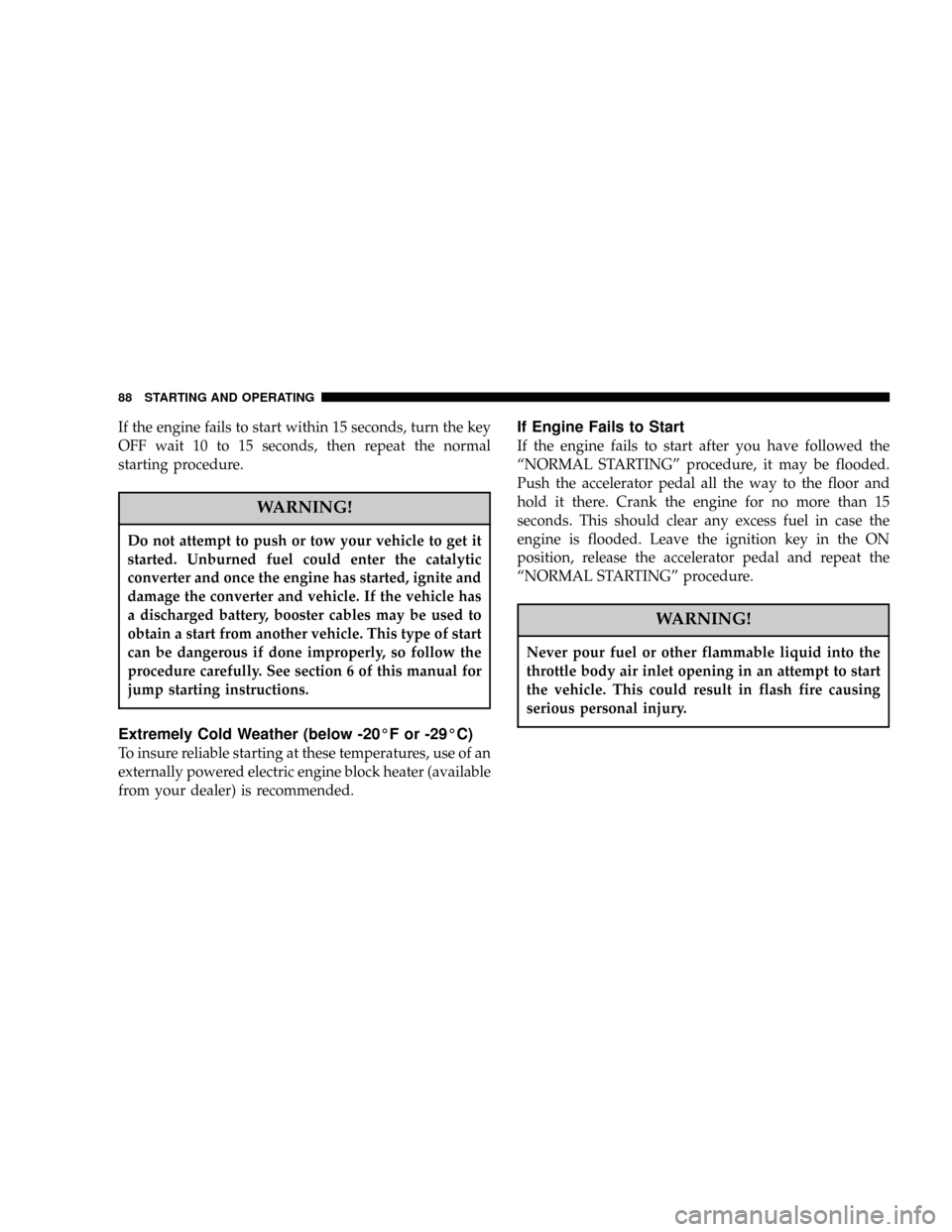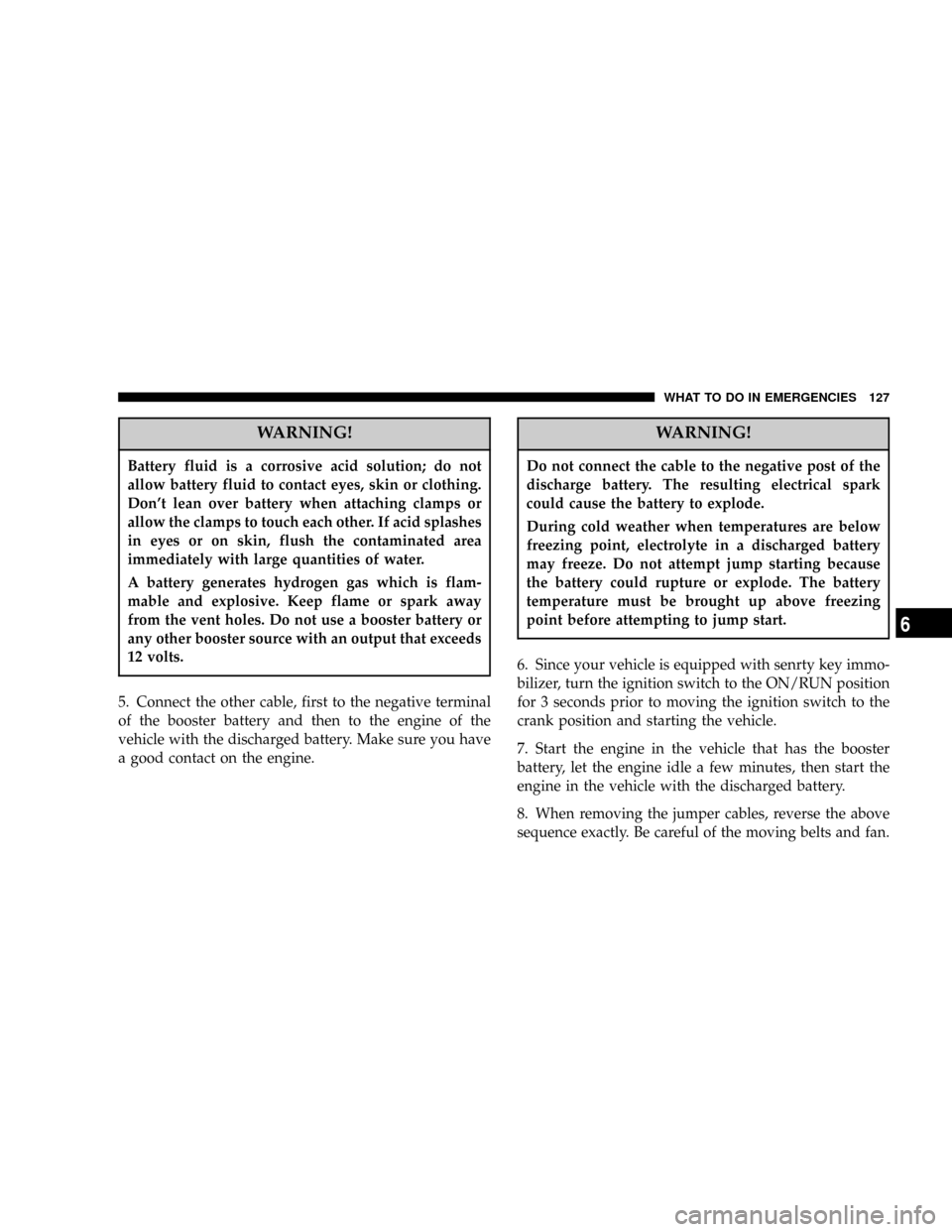2004 DODGE NEON SRT jump start
[x] Cancel search: jump startPage 88 of 200

If the engine fails to start within 15 seconds, turn the key
OFF wait 10 to 15 seconds, then repeat the normal
starting procedure.
WARNING!
Do not attempt to push or tow your vehicle to get it
started. Unburned fuel could enter the catalytic
converter and once the engine has started, ignite and
damage the converter and vehicle. If the vehicle has
a discharged battery, booster cables may be used to
obtain a start from another vehicle. This type of start
can be dangerous if done improperly, so follow the
procedure carefully. See section 6 of this manual for
jump starting instructions.
Extremely Cold Weather (below -20ÉF or -29ÉC)
To insure reliable starting at these temperatures, use of an
externally powered electric engine block heater (available
from your dealer) is recommended.
If Engine Fails to Start
If the engine fails to start after you have followed the
ªNORMAL STARTINGº procedure, it may be flooded.
Push the accelerator pedal all the way to the floor and
hold it there. Crank the engine for no more than 15
seconds. This should clear any excess fuel in case the
engine is flooded. Leave the ignition key in the ON
position, release the accelerator pedal and repeat the
ªNORMAL STARTINGº procedure.
WARNING!
Never pour fuel or other flammable liquid into the
throttle body air inlet opening in an attempt to start
the vehicle. This could result in flash fire causing
serious personal injury.
88 STARTING AND OPERATING
Page 119 of 200

WHAT TO DO IN EMERGENCIES
CONTENTS
mHazard Warning Flasher.................120
mIf Your Engine Overheats................120
mJacking And Tire Changing...............122
NPreparations For Jacking................122
NInstructions.........................122
mJump-Starting Procedures Due To A Low
Battery
..............................125
mDriving On Slippery Surfaces.............128
NAcceleration.........................128NTraction............................128
mFreeing A Stuck Vehicle.................129
mTowing A Disabled Vehicle...............130
NWith Ignition Key.....................130
NWithout The Ignition Key...............130
NTowing This Vehicle Behind Another Vehicle
(Flat Towing With All Four Wheels On The
Ground)............................130
6
Page 125 of 200

7. Finish tightening the nuts. Push down on the wrench
while tightening the wheel nuts. Alternate nuts until each
nut has been tightened twice. Correct wheel nut torque is
100 ft. lbs. (135 N´m.). If you are not sure about the
tightness, have them checked with a torgue wrench by
your dealer or at a service station.
8. Remove the wheel blocks and lower the jack until it is
free. Stow the lug wrench, replaced tire, and jack. Secure
all parts using the means provided.
WARNING!
A loose tire or jack thrown forward in a collision or
hard stop could endanger the occupants of the ve-
hicle. Always stow the jack parts and the spare tire in
the places provided.
9. Adjust the tire pressure as soon as possible.
NOTE:The spare tire well is designed to hold the
compact spare tire or a deflated (flat) tire. A fully inflated
tire will not fit in the spare tire well.
JUMP-STARTING PROCEDURES DUE TO A LOW
BATTERY
WARNING!
Take care to avoid the radiator cooling fan whenever
the hood is raised. It can start anytime the ignition
switch is on. You can be hurt by the fan.
WARNING!
Do not attempt to push or tow your vehicle to get it
started. Unburned fuel could enter the catalytic
converter and once the engine has started, ignite and
damage the converter and vehicle. If the vehicle has
a discharged battery, booster cables may be used to
obtain a start from another vehicle. This type of start
can be dangerous if done improperly, so follow this
procedure carefully.
WHAT TO DO IN EMERGENCIES 125
6
Page 127 of 200

WARNING!
Battery fluid is a corrosive acid solution; do not
allow battery fluid to contact eyes, skin or clothing.
Don't lean over battery when attaching clamps or
allow the clamps to touch each other. If acid splashes
in eyes or on skin, flush the contaminated area
immediately with large quantities of water.
A battery generates hydrogen gas which is flam-
mable and explosive. Keep flame or spark away
from the vent holes. Do not use a booster battery or
any other booster source with an output that exceeds
12 volts.
5. Connect the other cable, first to the negative terminal
of the booster battery and then to the engine of the
vehicle with the discharged battery. Make sure you have
a good contact on the engine.
WARNING!
Do not connect the cable to the negative post of the
discharge battery. The resulting electrical spark
could cause the battery to explode.
During cold weather when temperatures are below
freezing point, electrolyte in a discharged battery
may freeze. Do not attempt jump starting because
the battery could rupture or explode. The battery
temperature must be brought up above freezing
point before attempting to jump start.
6. Since your vehicle is equipped with senrty key immo-
bilizer, turn the ignition switch to the ON/RUN position
for 3 seconds prior to moving the ignition switch to the
crank position and starting the vehicle.
7. Start the engine in the vehicle that has the booster
battery, let the engine idle a few minutes, then start the
engine in the vehicle with the discharged battery.
8. When removing the jumper cables, reverse the above
sequence exactly. Be careful of the moving belts and fan.
WHAT TO DO IN EMERGENCIES 127
6
Page 194 of 200

Downshifting........................... 92
Drive Belts............................ 140
Driving
On Slippery Surfaces.................. 128
Electric Remote Mirrors................... 48
Emergency, In Case of
Jacking............................. 122
Jump Starting........................ 125
Towing............................. 130
Emergency Trunk Release................. 15
Emission Control System Maintenance....... 168
Engine
Break-In Recommendations............... 42
Checking Oil Level.................... 137
Jump Starting........................ 125
Oil ..........................137,165,166
Oil Change Interval................... 138
Oil Filter............................ 166
Oil Selection......................... 138
Oil Synthetic......................... 139
Overheating......................... 120
Temperature Gauge.................... 67Timing Belt.......................... 142
Exhaust Gas Caution..................... 43
Exhaust System........................ 147
Filters
Air Cleaner.......................... 142
Engine Fuel......................... 142
Engine Oil.......................140,166
Flooded Engine Starting................... 88
Fluid, Brake........................... 166
Fluid Capacities........................ 165
Fluid Leaks............................ 44
Fluid Level Checks
Manual Transaxle..................... 155
Fog Lights...........................54,63
Freeing A Stuck Vehicle.................. 129
Fuel.............................. 113,166
Adding............................. 116
Filler Cap........................... 116
Filter.............................. 142
Gauge.............................. 65
Light............................... 65
Octane Rating........................ 113
194 INDEX
Page 195 of 200

Fuses................................ 160
GasCap .............................. 116
Gasoline............................. 165
Gasoline, Reformulated.................. 114
Gasoline/Oxygenate Blends............... 114
Gauges
Coolant Temperature................... 67
Fuel................................ 65
Tachometer.......................... 64
Turbo Boost.......................83,113
General Information...................... 11
Glass Cleaning......................... 159
Hazard Warning Flasher.................. 120
Headlights............................. 54
Bulb Replacement..................... 163
Cleaning............................ 159
High Beam........................... 64
Switch.............................. 54
Hood Prop............................ 52
Hood Release.......................... 51
Hoses............................... 152Ignition
Key ................................. 9
Wiring System....................... 142
Immobilizer............................. 9
Infant Restraint......................... 36
Inside Rearview Mirror................... 47
Instrument Cluster.....................62,63
Instrument Panel and Controls.............. 61
Instrument Panel Cover.................. 159
Instrument Panel Lens Cleaning............ 159
Interior Appearance Care................. 158
Interior Fuses.......................... 161
Interior Lights.......................... 53
Intermittent Wipers...................... 56
Introduction............................ 4
Jack Operation......................... 122
Jump Starting......................... 125
Key, Programming....................... 11
Key, Replacement....................... 10
Key, Sentry............................. 9
Key-In Reminder......................... 9
INDEX 195
10